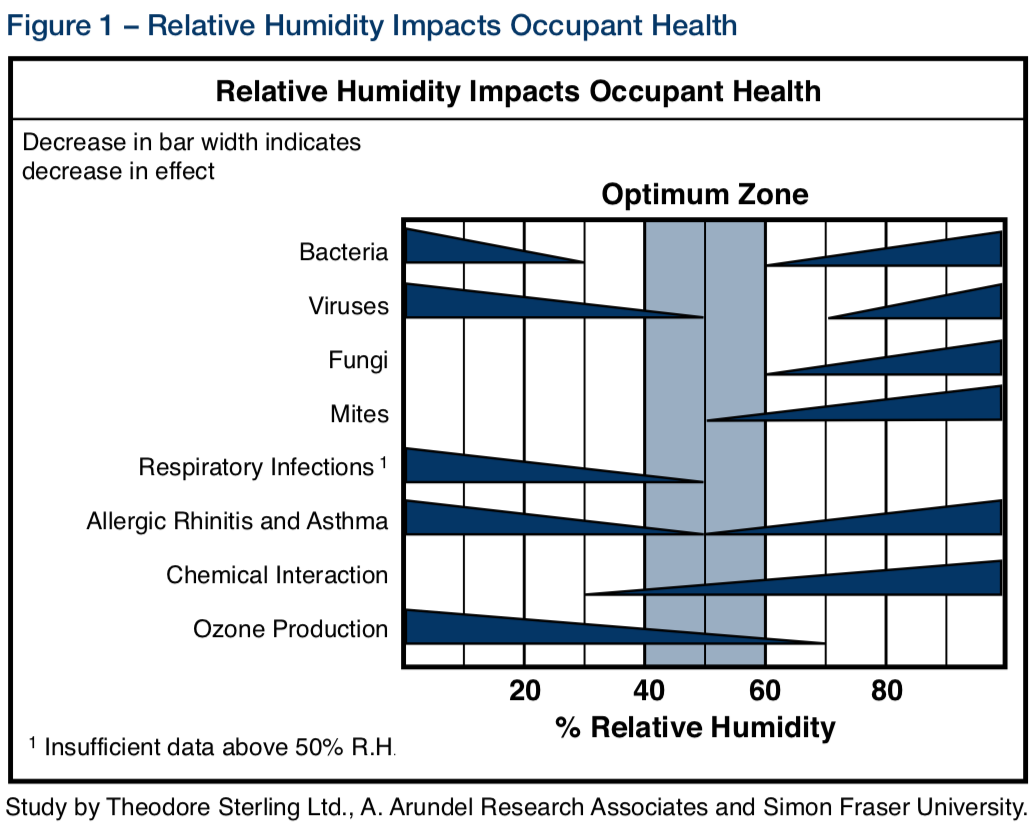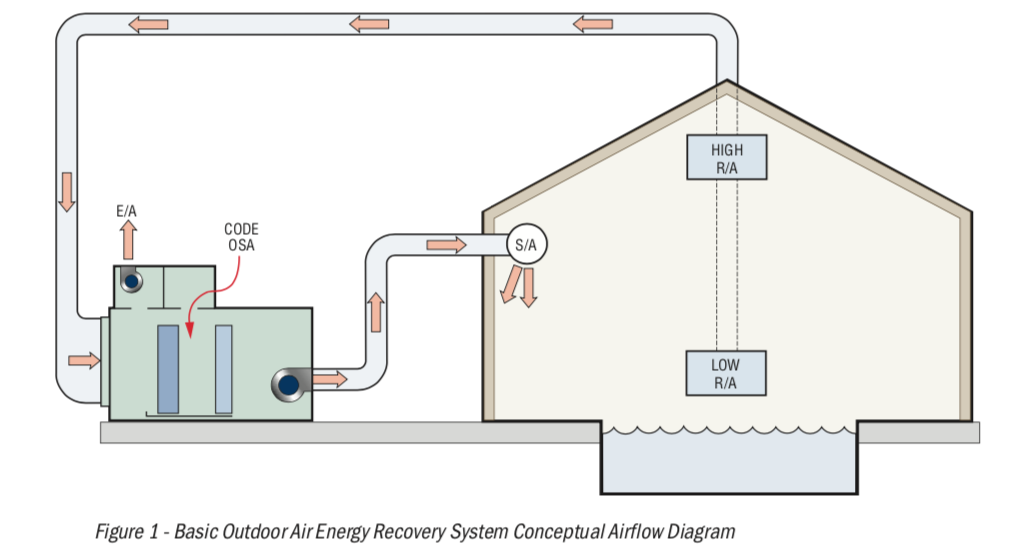Relative Humidity in Natatoriums
Relative Humidity (RH) is the amount of water vapor in the air, relative to how much the air can hold when 100% saturated. RH is expressed as a percentage (%), where 100% is total saturation, and 0% is zero moisture in the air.
For indoor swimming pools, RH is ideally kept somewhere between 50-60%, and is a critical part of indoor air quality and patron comfort. The ideal RH in a natatorium balances patron comfort with practicality for what a Pool Dehumidification Unit (PDU) can efficiently accomplish. It is simply not cost effective or practical to expect a PDU to deliver a much lower RH, especially when natatoriums have variables that are extreme. Indoor pools are nothing like office buildings, and should not be conditioned with simple air conditioners.
What is Relative Humidity?
RH = [(condensation rate) ÷ (evaporation rate)] x 100%
Water and air want to be in equilibrium, meaning the condensation rate equals the evaporation rate. As water vapor evaporates and goes airborne, other water vapor is condensing back into the swimming pool. When these two rates are identical, the natatorium is in equilibrium. But true equilibrium means a 100% RH, which is super uncomfortable for people. To cut that RH in half means removing a lot of moisture from the air with a PDU.
Patron comfort is largely about how "humid" the air feels in a natatorium. Not so much for swimmers, who are submerged in water...but for parents in the bleachers, lifeguards in the stands and coaches on the pool deck. Too much RH means the air is holding more moisture than is comfortable for people, so we get sweaty and...well if you have ever spent more than an hour on a pool deck, you know how miserable it can be. On the flip side, too low of an RH may be more comfortable for patrons, but requires a LOT more dehumidification.
(Lower RH↓) → (Increased Patron Comfort↑)
(Lower RH↓) → (Increased Dehumidification Demand↑) → (Increased Energy Costs↑)
Indoor pools have many factors that are considered extreme, from a dehumidification standpoint. That's why pool dehumidifiers are so robust and expensive...they have an enormous amount of work to do. The factors that impact RH include:
- Air Temperature
- Water Temperature
- Evaporation Rates
- Condensation Rates
- Vapor Pressure
These extreme variables put natatoriums in a league of their own, from a dehumidification and operations standpoint. An indoor pool cannot, and should never be compared to an office, or gym. It is paramount for mechanical engineers to either A) understand natatoriums with intimate detail, or B) acknowledge how extraordinary and difficult natatoriums are to design, and enlist the help of pool dehumidifier manufacturers.
Pool Dehumidification Unit (PDU) Sizing
PDUs need to be sized to deliver optimal RH at a certain desired range of temperature. The desired air temperature is usually determined by the pool's water temperature + 2ºF (to minimize evaporation).
According to one of the leading pool dehumidifier manufacturers in the country, Desert Aire Corp., PDUs are designed to handle specific parameters, like desired indoor temperature, and RH. The performance of a pool dehumidifier depends on many factors, and its capacity to do its job can be impacted when things deviate from the design parameters. Like when outside doors are opened in the winter, bringing in cold, dry outside air.
Here is a chart from one of Desert Aire's technical bulletins on PDU sizing:
The lower the outside temperature (which translates on this chart to a temperature of the glass windows), the less RH it takes for moisture to condense. The warmer the inside temperature, once again, the lower the RH needed. So if you have a cold winter day in Wisconsin and a 90ºF indoor air temperature for a swim school, condensation on windows can be a real challenge. Much of the reason why is because of the vast difference in temperature, known as Delta T, or ∆T.
Heat and Humidity Rise and Expand
Because heat and humidity both rise and expand, it is a common practice to install exhaust fans in the ceiling of an indoor swimming pool. Ceiling exhausts, in our opinion, are a big mistake. It is tempting to discard this hot, humid air to reduce the moisture burden on the PDU, but it does nothing for indoor air quality. Why? Because chloramine vapor does not rise...it's heavier than oxygen.
Design Parameters
A PDU needs to be able to deliver consistent temperatures and address three main factors of humidity: pool water evaporation, outdoor air, and people. People in the stands have different needs than people in the pool. And people in the pool splash it around, which agitates the water and creates more evaporation (increased surface area, bubbling, etc.). The general idea is to have a PDU that can handle between 50 and 60% RH within a certain temperature range. 60% is not just an ideal maximum, its the code required maximum.
Here is a chart from another leading pool dehumidifier manufacturer, Seresco:
The chart shows 40-60% RH is optimal, but Seresco's bulletin goes on to say most pools do not operate below 50% RH because of the extraordinarily high energy costs of doing so.
Try not to think of RH as a factor that can just be put wherever you want it...there's a sweet spot that balances energy efficiency, health and safety, and patron comfort. That sweet spot in a natatorium happens to be 50 - 60% RH, according to both Desert Aire and Seresco.
Knowing this desired RH range, and also knowing the desired temperature of the pool water, the PDU will then be sized accordingly, based on the location of the natatorium and its average annual climate. This is important because a critical part of pool dehumidification is outside make-up air. The PDU manufacturer needs to know all these elements so they size their system for a certain amount of moisture removal capability and yada yada yada.
Bottom line: RH depends on many variables, so to deliver a consistent RH, a pool dehumidifier has to be able to handle them. Consistency is key.
And one other note: commercial air conditioners are not the same as pool dehumidifiers. If you have air conditioners on an indoor pool, we advise you to start budgeting for a real pool dehumidifier. Using AC units for a natatorium is like expecting a packed, high-end commercial restaurant to do all their cooking in a basic home kitchen, with multiple chefs and assistants. Every day.
Conclusion
Relative Humidity (RH) measures water vapor in the air, expressed as a percentage of how much water vapor the air can hold when completely saturated at that given temperature.
For indoor swimming pools, the optimal RH is 50-55%. A pool dehumidifier will be selected based on the moisture load in the space, as its primary function is to deliver a consistent RH at a desired temperature (usually 2º warmer than the water temperature).

 By
By




